Sweden's Pionen
Ultra-Modern Underground Data Center
Underneath Stockholm, deep in the bedrock exists a data center better than any high tech lair Hollywood could probably dream up. Bahnhof, one of Sweden's largest ISP's has created a bunker of high tech goodness that is surely to astound.
The facility is called Pionen and once you get past the 16 inch thick entrance doors into the once nuclear bunker now converted to a data center, the spectacular sights that await are simply breathtaking. Replete with waterfalls, greenhouses, German submarine backup engines, and simulated daylight this facility has the added benefit of being able to withstand an almost direct hit by a hydrogen bomb.
The space Pionen now occupies was originally built during the Cold War era as a nuclear shelter. Located below 30 meters of solid bedrock the space was completely redesigned during 2007-2008. Now Boasting 11,950 sq ft of space it houses the Network Operations Center (NOC) for all of Bahnhof's operations. One of five data centers, it is the largest and is manned by a 15 member team of senior technical staff.
Backup power is generated by two Maybach MTU diesel engines that produce 1.5 Megawatts of power and were originally designed for submarines. The cooling is handled by "Baltimore Aircoil fans producing a cooling effect of 1.5 megawatts" which is enough to cool several hundred rack-mounted servers.
Triple redundant internet backbone pipes are split across fiber and copper and delivered via multiple physical paths into the mountain.
Conference Room
Left: View of servers from moon surfaced conference room. Right: Submarine backup engines
Network Operations Center
Waterfalls
In an interview over at Pingdom, when asked about the motivation behind Pionen, Jon Karlung, CEO of Bahnhof said “Rather than just concentrating on technical hardware we decided to put humans in focus. Of course, the security, power, cooling, network, etc, are all top notch, but the people designing data centers often (always!) forget about the humans that are supposed to work with the stuff.”
Data Center Layout - Source: Pingdom
“Since we got hold of this unique nuclear bunker in central Stockholm deep below the rock, we just couldn't’t build it like a traditional – more boring – hosting center,” he said. “We wanted to make something different. The place itself needed something far out in design and science fiction was the natural source of inspiration in this case – plus of course some solid experience from having been a hosting provider for more than a decade.”
Regarding the design of the facility, he said “I’m personally a big fan of old science fiction movies. Especially ones from the 70s like Logan’s Run, Silent Running, Star Wars (especially The Empire Strikes Back) so these were an influence,“ said Karlung. “James Bond movies have also had an impact on the design. I was actually looking for the same outfit as the villain ‘Blofeld’ in Bond and even considered getting a white cat, but that might have been going a bit far!”

Before Construction
When asked the motivation behind Pionen, Jon Karlung, CEO of Bahnhof said
“Rather than just concentrating on technical hardware we decided to put humans in focus. Of course, the security, power, cooling, network, etc, are all top notch, but the people designing data centers often (always!) forget about the humans that are supposed to work with the stuff.”
“Since we got hold of this unique nuclear bunker in central Stockholm deep below the rock, we just couldn't’t build it like a traditional – more boring – hosting center,” he said. “We wanted to make something different. The place itself needed something far out in design and science fiction was the natural source of inspiration in this case – plus of course some solid experience from having been a hosting provider for more than a decade.”
Regarding the design of the facility, he said “I’m personally a big fan of old science fiction movies. Especially ones from the 70s like Logan’s Run, Silent Running, Star Wars...
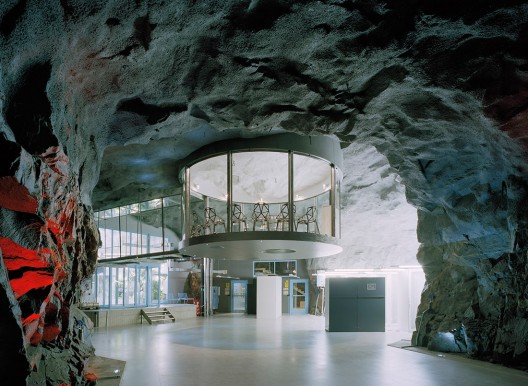
Architects: Albert France-Lanord Architects
Location:Stockholm, Sweden
Program: Datacenter
Collaborators: Frida Öster and Jonatan Blomgren
Geology Consultant: Geosigma AB
Construction: Albert France-Lanord Architects
Client: Bahnhof AB
Construction Area: 1,200 sqm
Project year: 2008
Photographs: Åke E:son Lindman
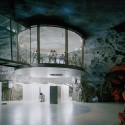
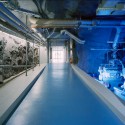

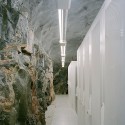
The project takes place in a former 1200 square meter anti-atomic shelter. An amazing location 30 meters down under the granite rocks of the Vita Berg Park in Stockholm. The client is an internet provider and the rock shelter hosts server halls and offices. The starting point of the project was to consider the rock as a living organism. The humans try to acclimate themselves to this foreign world and bring the ‘best’ elements from earth: light, plants, water and technology. We created strong contrasts between rooms where the rock dominates and where the human being is a stranger against rooms where the human being took over totally.
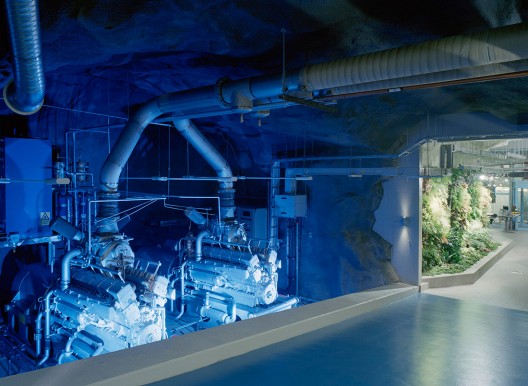

The choice of lightning has been very challenging. We tried to bring as much variation as possible. Otherwise it is very easy to loose the feeling of time in an enclosed space.
Our references come straight from science fiction films, mostly ‘Silent Running’ and a bunch of Bond films with Ken Adams set design.

One can describe the process in five different phases:
-planning
-destruction of the former office and blowing up the rock to create extra space.
-reinforce the cave. concrete work.
-technical installations. electrical.
-glass and steel work. paint and furnishing.
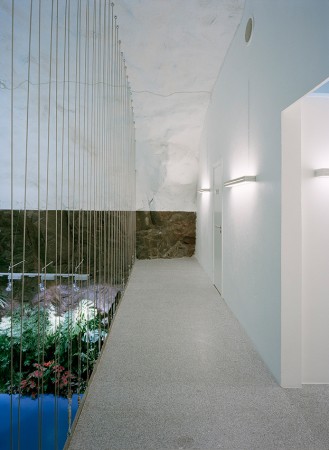
The client had a strong vision from the first brief and the result is only possible because of their persistence, the absence of compromise and great communication/ understanding between all parts under the process.
It has been very exciting to work with a space which at first didn’t offer one square angle: the rock. The main room is not a traditional space limited by surfaces but defined by the emptiness inside a mass.
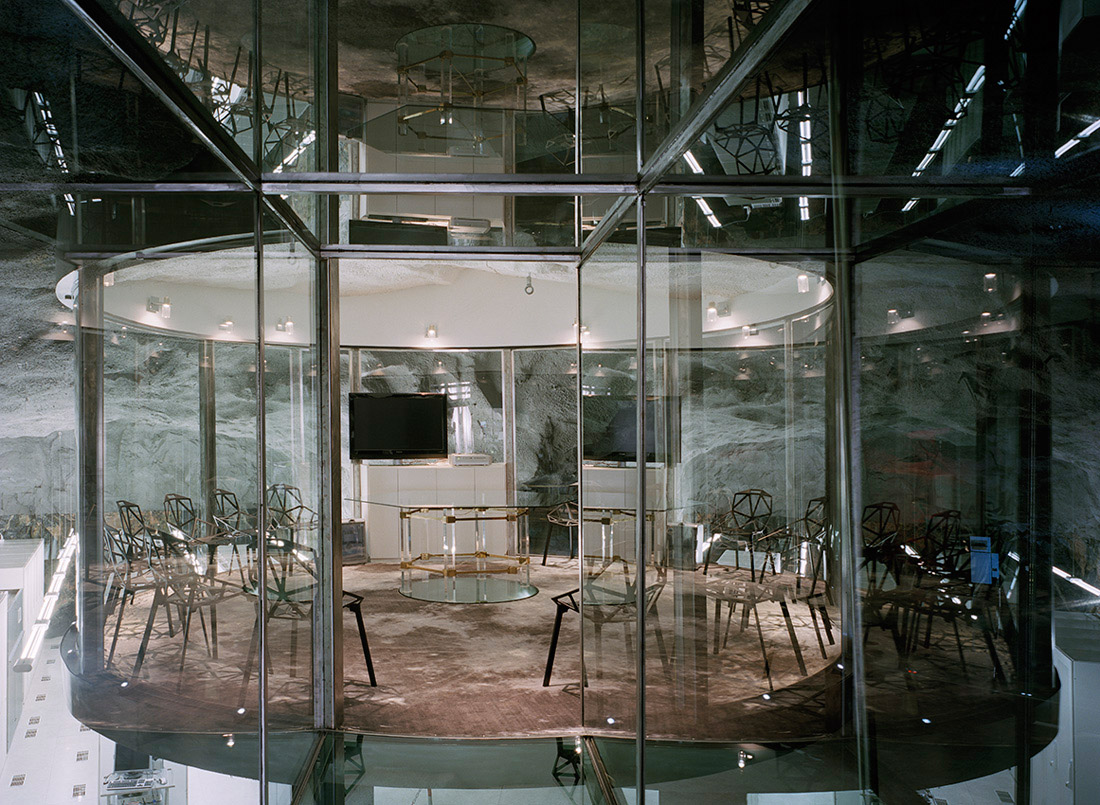
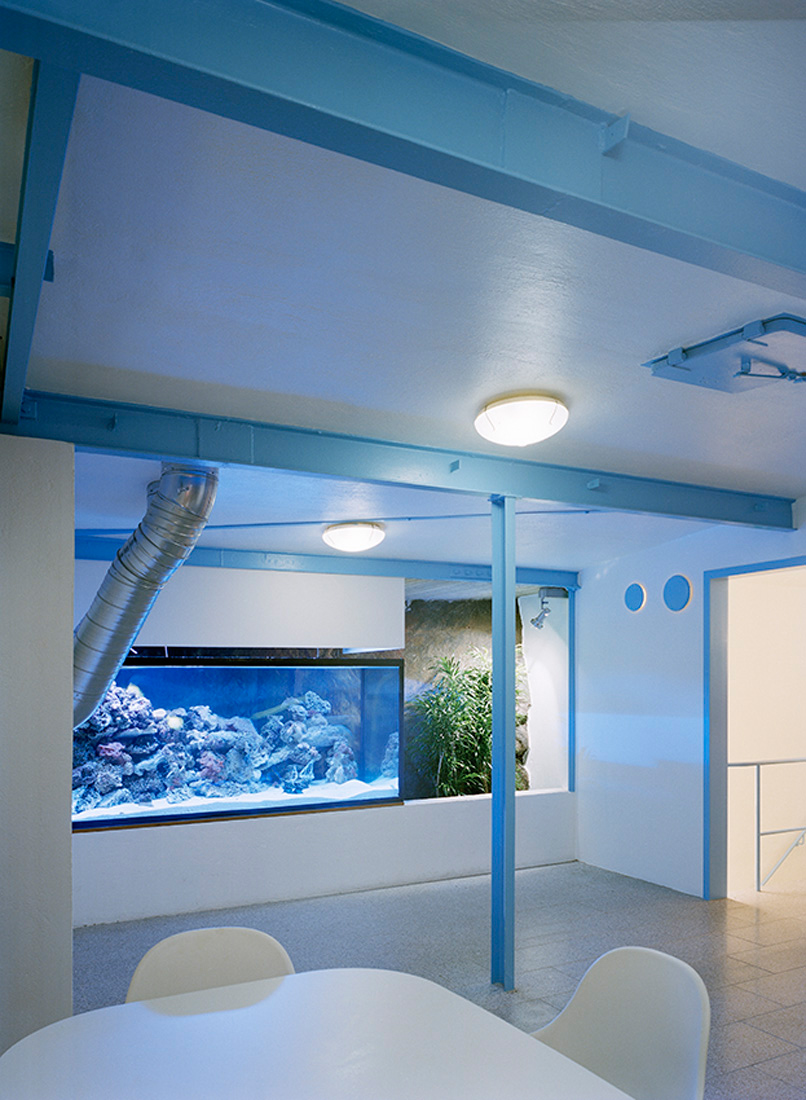
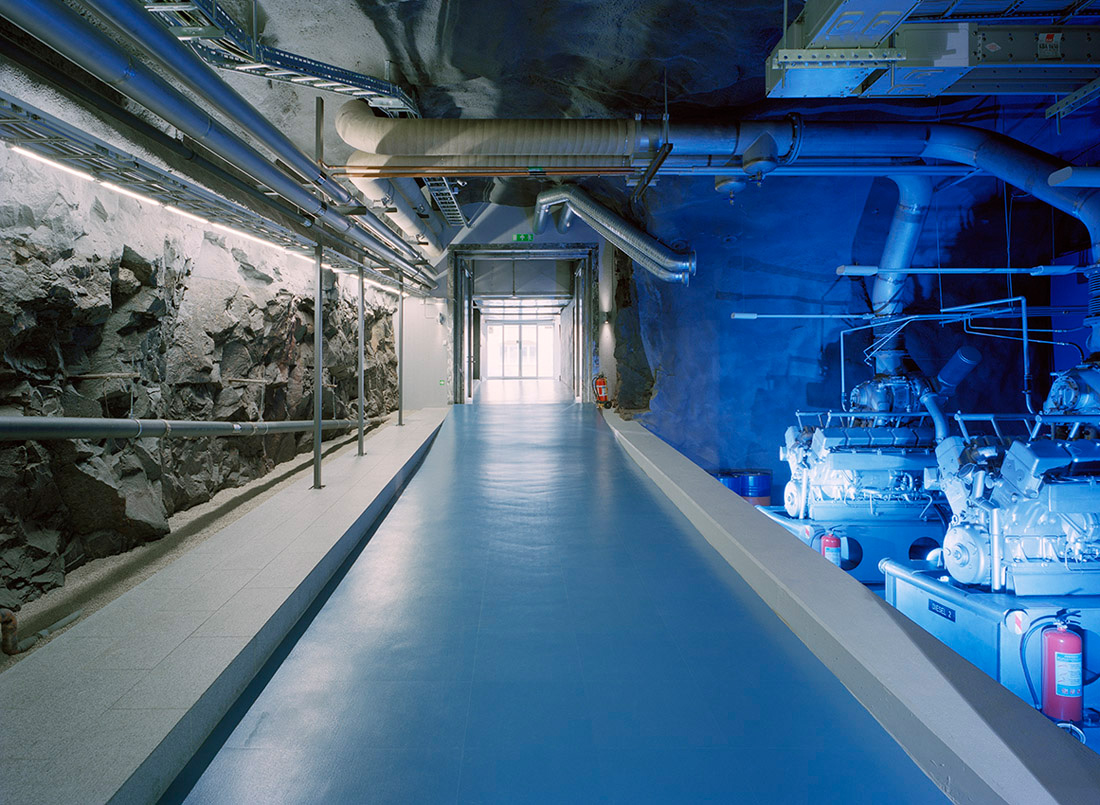
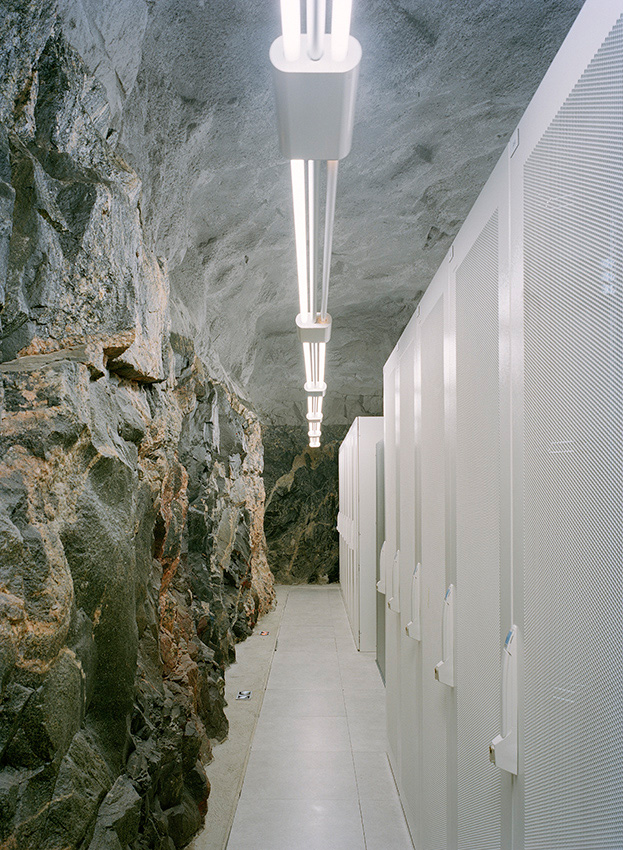
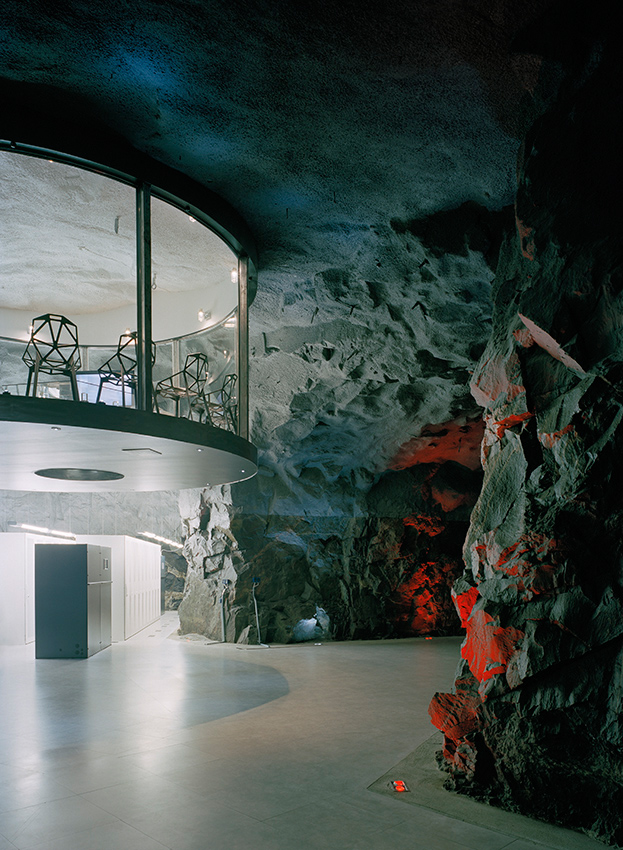
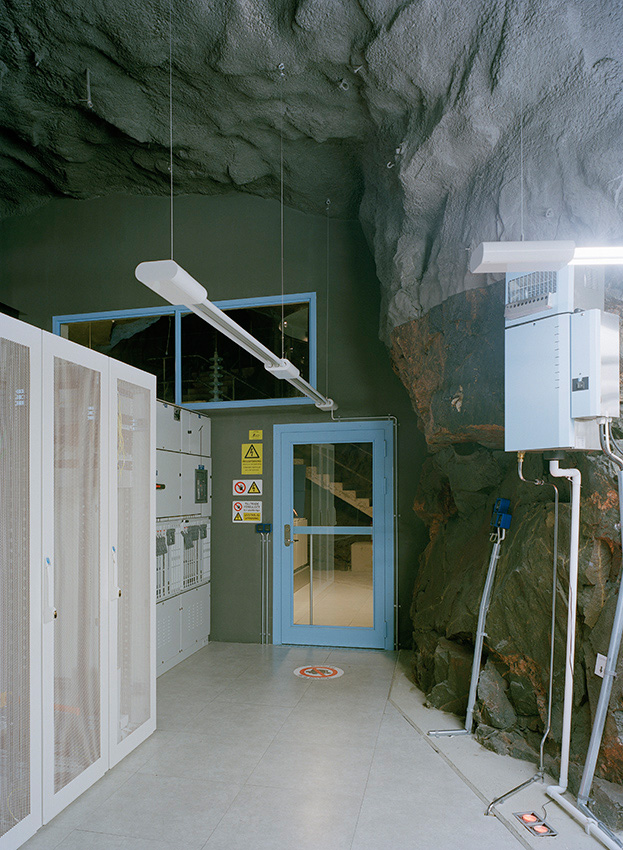
Underground Secure Data Center Operations
Technology based companies are building new data centers in old mines, caves, and bunkers to host computer equipment below the Earth's surface.
Underground Secure Data Center Operations have a upward trend.
Operations launched in inactive gypsum mines, caves, old abandoned coal mines, abandoned solid limestone mines, positioned deep below the bedrock mines, abandoned hydrogen bomb nuclear bunkers, bunkers deep underground and secure from disasters, both natural and man-made.
The facility have advantages over traditional data centers, such as increased security, lower cost, scalability and ideal environmental conditions. There economic model works, despite the proliferation of data center providers, thanks largely to the natural qualities inherent in the Underground Data Centers.
With 10,000, to to over a 1,000,000 square feet available, there is lots of space to be subdivided to accommodate the growth needs of clients. In addition, the Underground Data Centers has an unlimited supply of naturally cool, 50-degree air, providing the ideal temperature and humidity for computer equipment with minimal HVAC cost.
They are the most secure data centers in the world and unparalleled in terms of square footage, scalability and environmental control.
Yet, while the physical and cost benefits of being underground make them attractive, they have to also invested heavily in high-speed connectivity and redundant power and fiber systems to ensure there operations are not just secure, but also state-of-the-art.
There initially focused on providing disaster recovery solutions, and backup co-location services.
Clients lease space for their own servers, while other provides secure facilities, power and bandwidth. They offers redundant power sources and multiple high-speed Internet connections through OC connected to SONET ring linked to outside connectivity providers through redundant fiber cables.
Underground Data Centers company augments there core services to include disaster recovery solutions, call centers, NOC, wireless connectivity and more.
Strategic partnering with international, and national information technology company, enable them to offer technology solutions ranging from system design and implementation to the sale of software and equipment.
The natural qualities of the Underground Data Centers allow them to offer the best of both worlds premier services and security at highly competitive rates.
Underground Data Centers were established starting in 1990's but really came into there own after September 11 attacks in 2001 when there founders realized the former mines, and bunker offered optimal conditions for a data center. The mines, and bunkers offered superior environmental conditions for electronic equipment, almost invulnerable security and they located near power grids.
Adam Couture, a Mass.-based analyst for Gartner Inc. said Underground Data Centers could find a niche serving businesses that want to reduce vulnerability to any future attacks. Some Underground Data Centers fact sheet said that the Underground Data Center would protect the data center from a cruise missile explosion or plane crash.
Every company after September 11 attacks in 2001 are all going back and re-evaluating their business-continuity plans, This doesn't say everybody's changing them, but everybody's going back and revisiting them in the wake of what happened and the Underground Data Center may be just that.
Comparison chart: Underground data centers
Five facilities compared
| Name | InfoBunker, LLC | The Bunker | Montgomery Westland | Cavern Technologies | Iron Mountain The Underground |
| Location | Des Moines, Iowa* | Dover, UK | Montgomery, Tex. | Lenexa, Kan. | Butler County, Penn.* |
| In business since | 2006 | 1999 | 2007 | 2007 | Opened by National Storage in 1954. Acquired by Iron Mountain 1998. |
| Security /access control | Biometric; keypad; pan, tilt and zoom cameras; door event and camera logging | CCTV, dogs, guards, fence | Gated, with access control card, biometrics and a 24x7 security guard | Security guard, biometric scan, smart card access and motion detection alarms | 24-hour armed guards, visitor escorts, magnetometer, x-ray scanner, closed-circuit television, badge access and other physical and electronic measures for securing the mine's perimeter and vaults |
| Distance underground (feet) | 50 | 100 | 60 | 125 | 220 |
| Ceiling height in data center space (feet) | 16 | 12 to 50 | 10 | 16 to 18 | 15 (10 feet from raised floor to dropped ceiling) |
| Original use | Military communications bunker | Royal Air Force military bunker | Private bunker designed to survive a nuclear attack. Complex built in 1982 by Louis Kung (Nephew of Madam Chang Kai Shek) as a residence and headquarters for his oil company, including a secret, 40,000 square foot nuclear fallout shelter. The office building uses bulletproof glass on the first floor and reception area and 3-inch concrete walls with fold-down steel gun ports to protect the bunker 60 feet below. | Limestone mine originally developed by an asphalt company that used the materials in road pavement | Limestone mine |
| Total data center space (square feet) | 34,000 | 50,000 | 28,000 plus 90,000 of office space in a hardened, above-ground building. | 40,000 | 60,000 |
| Total space in facility | 65,000 | 60,000 | 28,000 | 3 million | 145 acres developed; 1,000 acres total |
| Data center clients include | Insurance company, telephone company, teaching hospital, financial services, e-commerce, security
monitoring/surveillance, veterinary, county government | Banking, mission critical Web applications, online trading | NASA/T-Systems, Aker Solutions, Continental Airlines, Houston Chronicle, Express Jet | Healthcare, insurance, universities, technology, manufacturing, professional services | Marriott International Inc., Iron Mountain, three U.S. government agencies |
| Number of hosted primary or backup data centers | 2 | 50+ | 13 | 26 | 5 |
| Services offered | Leased data center space, disaster recovery space, wholesale bandwidth | Fully managed platforms, partly managed platforms, co-location | Disaster recovery/business continuity, co-location and managed services | Data center space leasing, design, construction and management | Data center leasing, design, construction and maintenance services |
| Distance from nearest large city | Des Moines, about 45 miles* | Canterbury, 10 miles; London, 60 miles | Houston, 40 miles | Kansas City, 15 miles | Pittsburgh, 55 miles |
| Location of cooling system, includng cooling towers | Underground | Underground | Above and below ground. All cooling towers above ground in secure facility. | Air cooled systems located underground. Cooling towers located outside
| Chillers located above ground to take advantage of "free cooling." Pumps located underground. |
| Location of generators and fuel tanks | Underground | Above ground and below ground | Two below ground, four above ground. All fuel tanks buried topside. | Underground | Underground |
*Declined to cite exact location/disatance for security reasons.























No comments:
Post a Comment